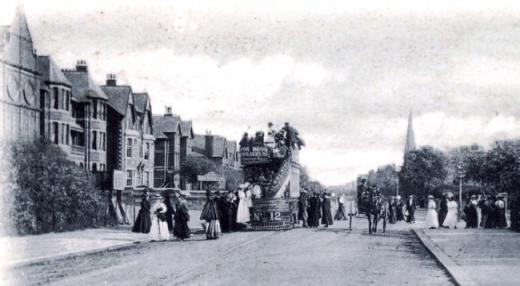Tramways in Lytham & St.Annes
The Belfast News-Letter, Monday, July 13, 1896
GAS MOTOR TRAMWAYS SYSTEM.
SPECIAL TELEGRAM.
BLACKPOOL, ,SATURDAY. —A Press view of the Blackpool St. Annes
and Lytham Tramway Company's new gas traction trams took place to-day at Blackpool.
Amongst those present were—Messrs. Roger Wallace, Q.C., chairman of the Gas
Traction Company, Limited; Fletcher Moulton,. Q.C. ; the Honourable Ormsby Gore,
and Mr. P. Holt, of Crossley Bros., Manchester ; Colonel Ellis, the Mayor of
Liverpool, and the Corporation and representatives of St. Anne's and Lytham.
 The tramway at present extends from
Blackpool to some distance past St. Annes, but when completed, which will
shortly be the case, there will be tramway communication from Lytham to
Blackpool, and by arrangement with the Blackpool Corporation Tramway Company
passengers will be able to book right through. The gas trams have machinery
underneath driven by a two-cylinder 15 horse-power Otto gas engine. Compressed
gas is stored capable of running the car for eight miles without refilling.
The gas is obtained from the town mains, compressed at the company's station,
and the process tilling, which occupied under one minute. is dune by means of
an india rubber pipe. and the operation is of the most simple description. The
engine at the compressing, station is of 8 horse-power, though it is not
necessary to keep it always at work. The tramway at present extends from
Blackpool to some distance past St. Annes, but when completed, which will
shortly be the case, there will be tramway communication from Lytham to
Blackpool, and by arrangement with the Blackpool Corporation Tramway Company
passengers will be able to book right through. The gas trams have machinery
underneath driven by a two-cylinder 15 horse-power Otto gas engine. Compressed
gas is stored capable of running the car for eight miles without refilling.
The gas is obtained from the town mains, compressed at the company's station,
and the process tilling, which occupied under one minute. is dune by means of
an india rubber pipe. and the operation is of the most simple description. The
engine at the compressing, station is of 8 horse-power, though it is not
necessary to keep it always at work.
The road from Blackpool to St. Annes is for the most partaking
country roads and by the sea coast. Sonic rather steep gradients had to be mounted,
which feat was easily accomplished by the cars running at a speed of eight miles
and hour, the limit allowed by the Board of Trade, though the cars are capable of
running twelve or fourteen miles an hour. The car is very handsome, and capable of
carrying forty passengers inside and twenty-four outside. The seating accommodation
both in and out is most comfortable, the latter being the ordinary garden seat. and
the absence of vibration, noticed to so considerable an extent on the motor cars,
is almost, if at entirely. absent. The fly-wheel of the engine when the car is
going makes 260 revolutions per minute, and when stationary about 80 per minute.
The machinery is started by means of an electric spark, which automatically
explodes the gas. The weight of the tramcar complete is about seven tons.
The idea of gas traction is absolutely new to England, though it
has been well tested in Germany, there being three systems at Dresden. Berlin. and
Dessan, and the cars have run since the inception of gas traction three hundred and
fifty thousand miles with the greatest success. Little progress has been made with
mechanical traction in this country, the great objection to electricity being the
overhead wires, which is the cheapest mode of electrical traction. The new mode,
however, has been warmly received by the Corporations of Blackpool, Lytham, and St.
Arms, the idea. being to make those three places one large watering place, or one
large Blackpool.

The initial expenditure is the chief objection. to underground
conduits, but it is claimed that gas motor cars will fulfil the varying
requirements of tramway work. All parts of the propelling engine are arranged so
that they can he easily reached both from above and underneath for purposes
of oiling, cleaning, and repairing. The expense of gas as compared with electricity
is small, the price per mile for gas alone being one penny, that amount being
arrived at on the basis of 2s 6d per thousand feet.
In Germany the official figures allow that the total charges per
horse-traction is 5½d per mile; electricity, 3½d; and gas, 2½d. The reason of the
cheapness of gas is due to the fact that no conductors or expensive machinery ere
necessary. Another advantage to which attention is called by the Gas Traction
Company is that there is no soot (a fact which will be appreciated by Lancastrians,
who are overrun with smoking and ugly steam trams), smoke, noise, vibration, or
smell. One eight horse-power engine is capable of I compressing gas sufficient for
twenty trams, whereas electricity would require an engine of two hundred
horse-power.
A luncheon was held during the afternoon at the Clifton Arms
Hotel. Lytham, over which Mr. Alderman Pilling. ex-Mayor of Southport, presided,
and was supported by representatives of the surrounding Corporations. The chairman
said the tramway was a great advance in civilisation. Blackpool, hem said, would
take St. Annes by the hand, and St. Annes would grasp Lytham, and there would be
houses from one end to the other, and some day, he, said, the estuary night be
spanned, and Lytham and Southport contacted by a bridge. Colonel Ellis. who
proposed he toast of "The Tramway Company," said the system was the best in the
country. The other speakers included the Mayor of Blackpool, Mr. ?fetcher Moulton,
Q.C. ; Mr. Roger Wallace,'
; and Dr. Farrell.
|